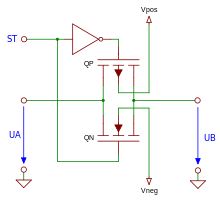Transmission gate
A transmission gate is similar to a relay that can conduct in both directions or block by a control signal with almost any voltage potential. It is CMOS based switch in which PMOS passes a strong 1 but poor 0 and NMOS passes strong 0 but poor 1. Both PMOS and NMOS work simultaneously.
Structure

In principle, a transmission gate made up of two field effect transistors, in which - in contrast to traditional discrete field effect transistors - the substrate terminal (Bulk) is not connected internally to the source terminal. The two transistors, an n-channel MOSFET and a p-channel MOSFET are connected in parallel with this, however, only the drain and source terminals of the two transistors are connected together. Their gate terminals are connected to each other via a NOT gate (inverter), to form the control terminal.

As with discrete transistors, the substrate terminal is connected to the source connection, so there is a transistor to the parallel diode (body diode), whereby the transistor passes backwards. However, since a transmission gate must block flow in either direction, the substrate terminals are connected to the respective supply voltage potential in order to ensure that the substrate diode is always operated in the reverse direction. The substrate terminal of the p-channel MOSFET is thus connected to the positive supply voltage potential and the substrate terminal of the n-channel MOSFET connected to the negative supply voltage potential.
Function

When the control input is a logic zero (negative power supply potential), the gate of the n-channel MOSFET is also at a negative supply voltage potential. The gate terminal of the p-channel MOSFET is caused by the inverter, to the positive supply voltage potential. Regardless of on which switching terminal of the transmission gate (A or B) a voltage is applied (within the permissible range), the gate-source voltage of the n-channel MOSFETs is always negative, and the p-channel MOSFETs is always positive. Accordingly, neither of the two transistors will conduct and the transmission gate turns off.
When the control input is a logic one, so the gate terminal of the n-channel MOSFETs is located at a positive supply voltage potential. By the inverter, the gate terminal of the p-channel MOSFETs is now at a negative supply voltage potential. As the substrate terminal of the transistors is not connected to the source terminal, the drain and source terminals are almost equal and the transistors start at a voltage difference between the gate terminal and one of these conducts.
One of the switching terminals of the transmission gate is raised to a voltage near the negative supply voltage, a positive gate-source voltage (gate-to-drain voltage) will occur at the N-channel MOSFET, and the transistor begins to conduct, and the transmission gate conducts. The voltage at one of the switching terminals of the transmission gate is now raised continuously up to the positive supply voltage potential, so the gate-source voltage is reduced (gate-drain voltage) on the n-channel MOSFET, and this begins to turn off. At the same time, the p-channel MOSFET has a negative gate-source voltage (gate-to-drain voltage) builds up, whereby this transistor starts to conduct and the transmission gate switches.
Thereby it is achieved that the transmission gate passes over the entire voltage range. The transition resistance of the transmission gate varies depending upon the voltage to be switched, and corresponds to a superposition of the resistance curves of the two transistors.
Applications
Electronic switch
Transmission gates are used in order to realize electronic switches and analog multiplexers. If a signal is connected to different outputs (changeover switches, multiplexers), multiple transmission gates can be used as a transmission gate to either conduct or block (simple switch). A typical example is known as the 4066 4-way analog switch which is available from various manufacturers.[1]
Analog multiplexer
Many mixed-signal systems use an analog multiplexer to route several analog input channels to a single ADC. [2][3][4]
Logic circuits
Logic circuits can be constructed with the aid of transmission gates instead of traditional CMOS pull-up and pull-down networks. Such circuits can often be made more compact, which can be an important consideration in silicon implementations.
Negative voltages
By using a transmission gate to switch alternating voltages (e.g.: audio signal), the negative power supply potential must be lower than the lowest signal potential. This ensures that the substrate diode will remain locked even at negative voltages. Although the transmission gate can still switch to logic voltage levels, there are special versions with integrated level shifters.
See also
References
Article Google-Translated from German Wikipedia. English article was deleted 2013 due to copyright.
- Ulrich Tietze, Christoph Schenk: Halbleiter-Schaltungstechnik. 12. Auflage, Springer, Berlin/Heidelberg/New York 2002, ISBN 3-540-42849-6.
- Erwin Böhmer: Elemente der angewandten Elektronik. 15. Auflage, Vieweg & Sohn Verlag | GWV Fachverlage GmbH, Wiesbaden 2007, ISBN 978-3-8348-0124-1.
- Klaus Fricke: Digitaltechnik. 6. Auflage, Vieweg & Sohn Verlag | GWV Fachverlage GmbH, Wiesbaden 2009, ISBN 978-3-8348-0459-4.
- ↑ 4066 Datenblätter
- ↑ Franco Zappa. "Electronic Systems". Section 6.9: Analog Multiplexers.
- ↑ John G. Webster. "Electrical Measurement, Signal Processing, and Displays". 2003. p. 36-12.
- ↑ Robert A. Pease. "Troubleshooting Analog Circuits". 2013. p. 132.